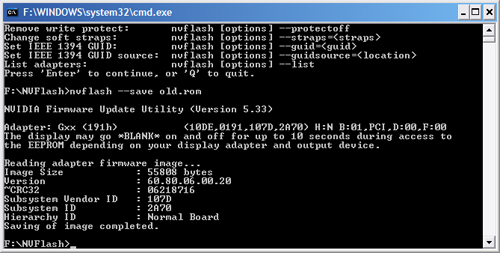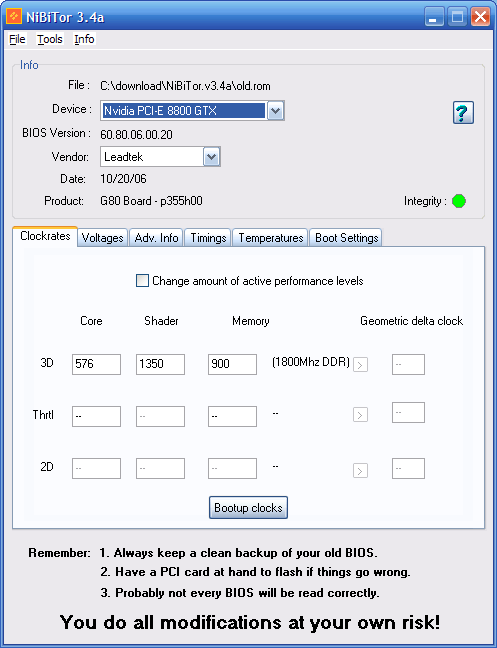Getting the Most Out Of Your Hardware: Video Card Utility Roundup
by Ryan Smith on July 5, 2007 12:00 PM EST- Posted in
- GPUs
BIOS Flashing
As the riskiest but most possibly most rewarding way to adjust a video card, we save BIOS flashing for last. Unlike with motherboards BIOS flashing still isn't a technique widely supported by manufacturers, so this is one of the many ways to void your warranty on a piece of hardware that can cost two to five times as much as a motherboard; caution is a must. On the positive side, recovering from a bad BIOS flash is easier with a video card than a motherboard as it's simply a matter of using another video card to view things, either via a PCI slot or a second PCIe slot for the many boards these days that offer 2+ x16 slots.
Generally BIOS flashing should be avoided whenever possible but for GeForce 8000 series owners looking for advanced overclocking options it's effectively inevitable. Flashing the BIOS is the only way to adjust the shader clock independent of the core clock along with being able to adjust some voltages. For this reason BIOS flashing is required where previously software tools would suffice.


For most other cards BIOS flashing does not offer a notable difference that software cannot provide. The few advantages here are limited to being able to program the BIOS to use its overclocked settings without software intervention (useful for Windows Vista x64 in particular), adjusting memory timings for better overclocks, and some older cards can have disabled features reenabled this way.










17 Comments
View All Comments
takumsawsherman - Friday, July 6, 2007 - link
AMD/ATI and NVIDIA are totally out of control. It's like they put 13-year olds in charge of the design, and State Government bureacrats are the programmers. I will focus on ATI, though NVIDIA seems to want to follow in their footsteps.1. Huge resource hog - the article mentions this, but one has to sit and time it themselves to realize what garbage this software is. Insane load times, just to switch output to a TV, or make basic adjustments. My trusty old Matrox G400Max 8 years ago in a matter of a few seconds, and the image looked better on TV as well. Speaking of Output to TV (or another monitor), under the old control panel, it was a check box. Now, one has to drag an icon of a TV into a box. Genius.
2. Speaking of 13 year olds, what is with the cartoon characters dominating the interface. Am I supposed to get excited seeing that? Is it supposed to reward me for my waiting? And the stupid buttons that are harder to see than normal buttons, on top of brushed metal? Awesome, dude! Why not have a nice control panel, that has all of the controls within an intuitive system, somewhat like what Matrox used to have with Powerdesk? Hell, with that system, I could increment the refresh rate until I reached the limit of my Viewsonic at 116hz. That is power, and control.
There is more that I could detail, but I need to get back to work. But no apologies should be made for the teams that design these monstrosities. They are not suitable for basic users. Basic users would think that perhaps their computer was not working, based on the load time. They are not suitable at all, and they should literally be thrown in the garbage. The people responsible for approving these designs, and team responsible for creating the design and basing it on .NET, should be fired. Then maybe somebody like Andy Hertzfeld should be brought in to lead the new teams.
I thought that with AMD's purchase of ATI, this outcome would be fast-tracked. Unfortunately, whoever was in charge probably still is in charge.
PrinceGaz - Friday, July 6, 2007 - link
Good article, I think I'll have a look at ATITool as that sounds ideal for my needs (I already use nHancer and have used RivaTuner in the past).My question is why are there no links to any of the third-party utilities you are so enthusiastic about? I know they're easy enough to find with a quick search, but it seems strange that you don't provide links to their official site. I assume it isn't because in at least one case it would mean linking to a site which probably competes with AT for ads and visitors? :)
Spoelie - Friday, July 6, 2007 - link
Specifically, getting it to do all the clock/voltage/fan changing (auto 3D overclocking feature) instead of the standard drivers, made my x1950xt with even the standard HSF a very pleasant card.2d clocks standard 500/600 @var fan (minimum 29%), now 300/400 @22% constant fan.
3d clocks standard 625/900 @var fan (up to 70%+), now 625/900 @59% constant fan.
+ fcourse voltage changes
For older games that do not need as much grunt, you can set an exception so it uses the 2D clocks, for completely silent gaming. Configuring the fan at a constant not-too-loud speed that is sufficient to cool the GPU at the 3D clocks, gets rid of the fan winding up and down during gaming annoyance.
And all the other goodies, for icing on the cake ^^
yacoub - Thursday, July 5, 2007 - link
ATITool would be perfect if its dynamic temperature-sensor-based fan throttling worked on more cards. It's hard to tell if the issue is with card hardware or with ATITool's developer, but either way it's frustrating to have a high-end GPU and yet not be able to have the fan throttle with detected temps per user settings. This worked perfectly on my 9800Pro and X800XL, but does not work at all on my 7900GT and apparently doesn't work right on X1900 series ATi cards not 8800 series NVidia cards either.It's a shame, because ATITool is such an awesome little program otherwise. It's by far much more user-friendly and easy to configure than something like RivaTuner (last I checked, which was a while ago).
Spoelie - Friday, July 6, 2007 - link
Ati tray tools has the support you mentioned for the X1xxx range of cards, try that for a change.yacoub - Thursday, July 5, 2007 - link
"not" should be "nor".Also I should add that SpeedFan manages to do this temp-based fan throttling wonderfully for my CPU and has for a couple years now. I want this ability for my GPU as well, as I was able to do with older gen GPUs.... how can we LOSE this feature when things are supposed to IMPROVE with newer generation hardware?
It's especially troublesome since the latest GPUs all seem to run a really low setting in Windows and FULL BLAST in 3D gaming. It's an on/off switch instead of a dynamic throttle the way ATITool is capable of doing (with older cards).
strikeback03 - Friday, July 6, 2007 - link
Speedfan has not worked with either of the hardware combos I have tried it with. I'm gonna see if any of these GPU utilities can keep my video card fan from turning on randomly though.I'd be happy if the nVidia utility would let me disable the popup message about "SLI is disabled" every time the computer is turned on, considering the motherboard does not support SLI and there has never been a second video card.
The Boston Dangler - Thursday, July 5, 2007 - link
yeah, speedfan is great. try rivatuner for controlling vid fan speeds.The Boston Dangler - Thursday, July 5, 2007 - link
Although you state that AMD and Nvidia need to do much better, you were way too soft on them. Perhaps your experiences have been much better than my own.No mention of Coolbits or NVTempLogger? Maybe because they are XP-only?
I dumped ATI years ago due to their weak hardware, CCC + .NET was the last straw. That, and the media thingy was nothing more than WMP with ATI's skin. Pure garbage. At very least, it let me have ANY video source as wallpaper, about 5 years before Vista's Dreamscene or whatever it's called.
That leaves Nvidia. Under XP, the old control panel was excellent. Coolbits added freq adjustments, RivaTuner did not integrate. All other settings were easily laid out for me to tinker with, and very functional. However, the new-fangled control panel had only about 10% of the settings as the old one. The nTune utility was 100% fatal to my motherboard, freezing up the moment the .exe was run. This was on an Asus A8N32-SLI, the premiere mobo of the day. So sad...
Now that I've regrettably installed Vista, I'm stuck with the moronic new control panel. After manually enabling visibility of every possible setting, I'm left with a tiny fraction of the settings I had under XP. Many of these will do nothing, some will break apps or the entire machine. nTune now works under Vista, although the one and only thing it does is monitor and log vid temps. I look at the screen shots AT posts and I wonder "Where the Hell did my settings and monitoring go?"
Although you didn't get into PureVideo in this piece, I'd like to bring it up. Where do they get off charging me for a driver, for the hardware I already purchased? Unlike Creative, support was stated, and it's functionality was promised. "Now with PureVideo technology" and "Free PureVideo support in this driver release". I, and many others, interpreted that to mean the PureVideo software was included. WRONG. It remains $20 - $50. I tried the demo, and what does $20 - $50 get you? Crap. After much fiddling, I was able to match the PQ I had without PV. It works with only this player and that file type, which covers about zero of my PC vid watching. For DVD's, my Denon DVD player whips PV and AVIVO's asses, every goddamn time. It isn't worth "free", nevermind $50.
Excuse me if I drifted into a rant, but it's frustrating. The disparity between the quality of hardware and software seems to be growing right across the board, no pun intended.
Ryan Smith - Thursday, July 5, 2007 - link
There's a common misconception between PureVideo the hardware, and PureVideo the software; this was a poor choice in naming by Nvidia. The entire suite of PureVideo hardware features can be access by any application using the DXVA interface and some knowledge of what features are available. The latest versions of PowerDVD and WinDVD have no problem here.The problem is that when Nvidia was shipping its earliest PureVideo hardware, the support from Cyberlink(PowerDVD) and Intervideo(WinDVD) wasn't where Nvidia wanted it, so they created their own MPEG2 decoder in order to showcase what the hardware could do. They eventually called this decoder the PureVideo Decoder, and this was their mistake. Thankfully this problem is slowly going away; I've heard there won't be any more updates to the PureVideo Decoder so it will ultimately be discontinued.